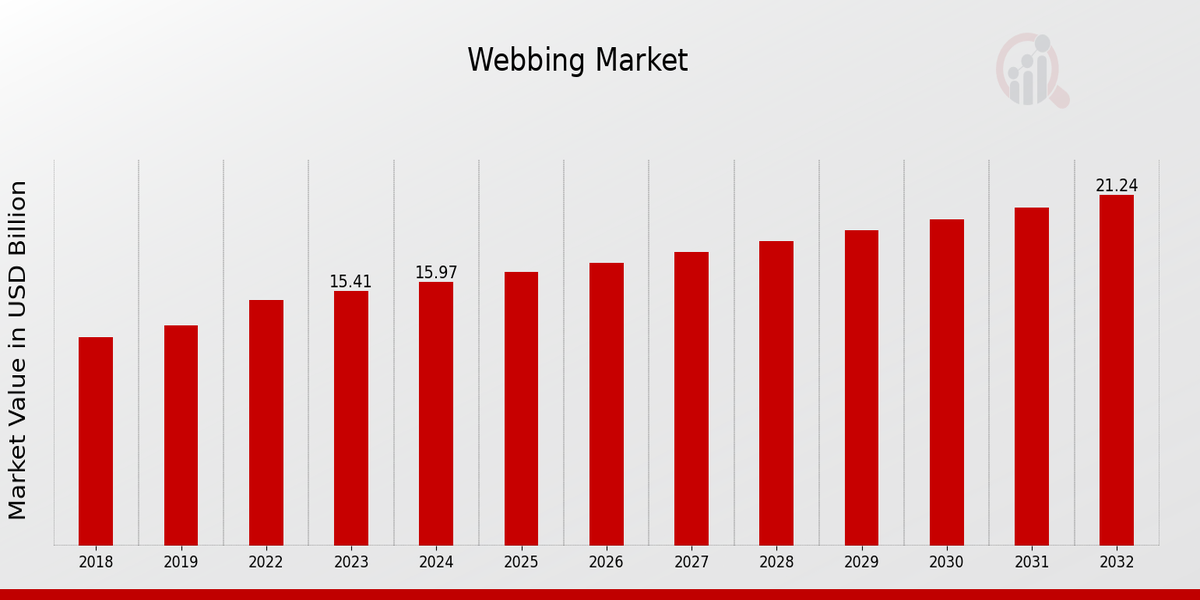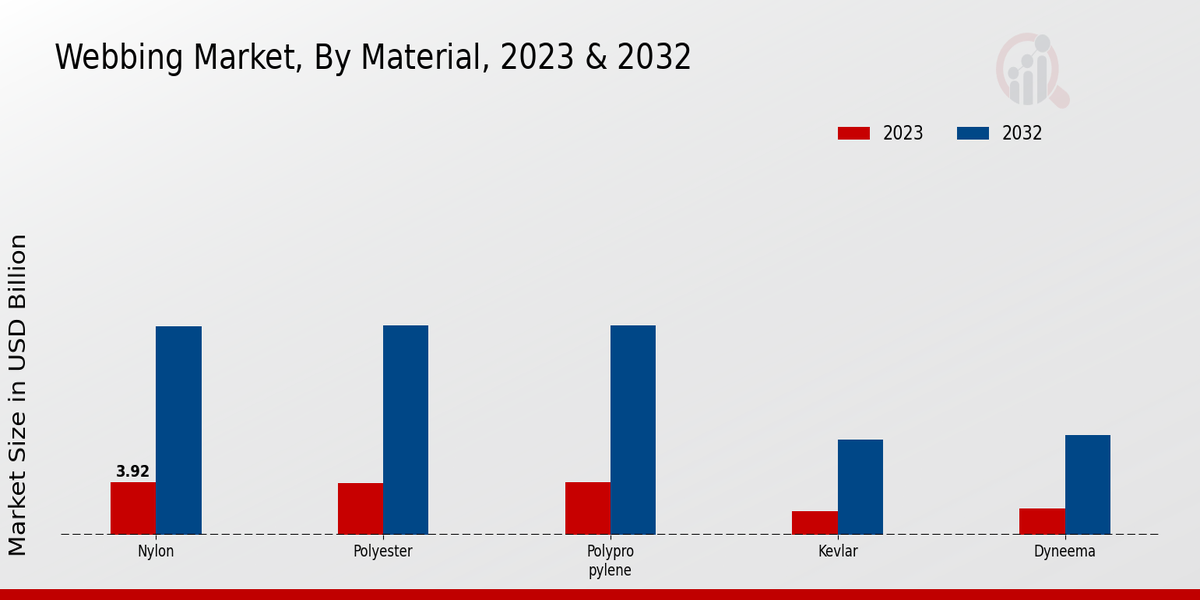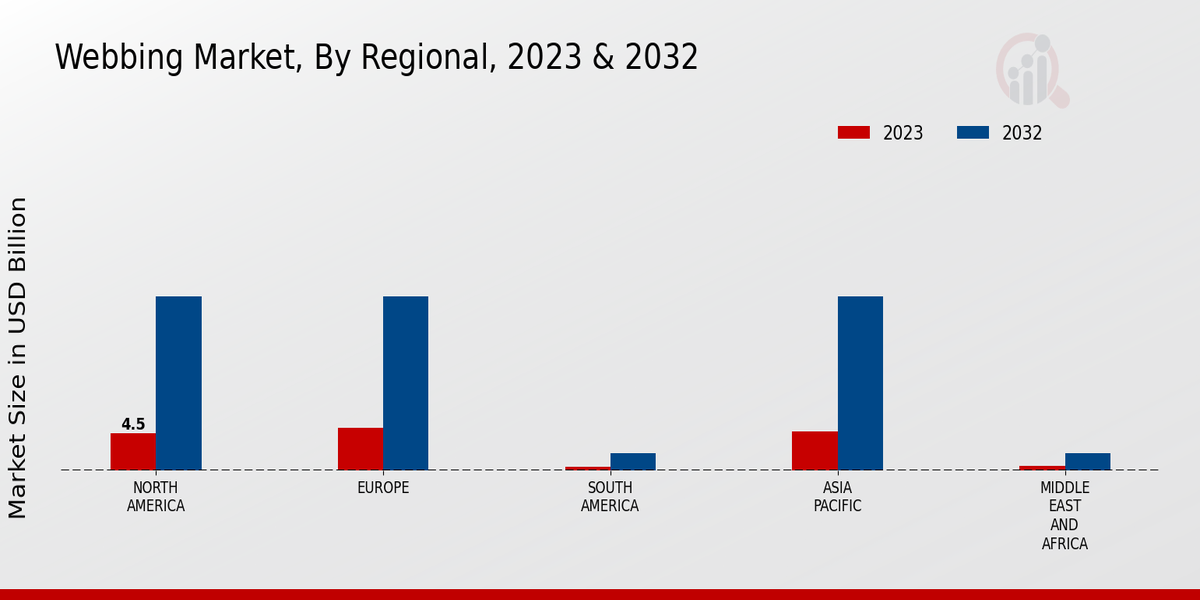Global Webbing Market Overview
The Webbing Market Size was estimated at 16.55 (USD Billion) in 2024. The Webbing Industry is expected to grow from 17.15 (USD Billion) in 2025 to 23.64 (USD Billion) by 2034. The Webbing Market CAGR (growth rate) is expected to be around 3.63% during the forecast period (2025 - 2034).
Key Webbing Market Trends Highlighted
The webbing market is poised for continued growth driven by increasing demand from end-use industries such as automotive, construction, and military. The lightweight, high-strength properties of webbing make it an ideal material for a wide range of applications, including seat belts, cargo straps, and protective gear.Key market drivers include the growing adoption of lightweight materials in automotive and aerospace industries, rising demand for safety and security equipment, and increasing popularity of outdoor activities. Manufacturers are exploring opportunities to expand into new markets by developing specialized webbing products tailored to specific end-use applications.Recent trends in the webbing market include the emergence of eco-friendly and sustainable materials, such as recycled PET and biodegradable fibers. Additionally, advancements in manufacturing technologies have led to the development of high-performance webbing products with enhanced durability, chemical resistance, and UV stability.
 Source: Primary Research, Secondary Research, MRFR Database and Analyst Review
Source: Primary Research, Secondary Research, MRFR Database and Analyst Review
Webbing Market Drivers
Increasing Demand for Lightweight and Durable Materials
The webbing market is being driven by increasing demand for lightweight and durable materials in numerous industries such as automotive, aerospace, and construction. As a versatile and affordable material with a high strength-to-weight ratio, webbing is gradually becoming the material of choice in critical applications where weight reduction and long-lasting durability are the key specifications. The use of webbing in seat belts, airbags, and other safety systems has seen a rapid increase in the automotive industry, for example.Moreover, the rise of outdoor activities and action sports has generated a demand for durable and lightweight webbing used in backpacks, harnesses, and other gear.
Technological Advancements and Innovation
The webbing market is largely focused on rapid technological advancements and continued innovation. Due to the development of new materials and manufacturing systems, webbing has received enhanced properties and can perform highly. High-strength fibers, such as Dyneema and Vectran, have a great advantage on the market, as these materials enable the production of strong and lightweight webbing. From the perspective of the manufacturing process, weaving and finishing of webbing and poly webbing, as well as synthetic webbing, was improved to provide better durability, flexibility, and look webbing has nowadays.Due to continuous innovation, webbing is widely used in various industries, as it is a reliable means of binding or covering things.
Growing Emphasis on Safety and Regulations
An increasing focus on safety and regulatory compliance across a range of industries has been driving the use of webbing for safety-critical applications. For instance, as a mission-critical component of fall protection systems – such as harness and lanyard – webbing helps to save the lives of numerous construction, mining, and other hazardous industries workers. More stringent regulations and standards applied to safety equipment are driving the use of webbing that meets certain safety and performance requirements, in turn fostering advances in the Webbing Market Industry.
Webbing Market Segment Insights
Webbing Market Material Insights
The Webbing Market is divided based on material into Nylon, Polyester, Polypropylene, Kevlar, and Dyneema. The Nylon segment accounted for the highest market share of the market in 2023 and is further expected to continue its dominance over the forecast period. The use of Nylon webbing is highly durable, resistant to abrasion, and strong compared to its mass. They can also be used in a wide variety of applications, including but not limited to backpacks, safety harnesses, and military equipment. The Polyester segment is expected to be the fastest-growing segment over the forecast period.It is lightweight, UV resistant, and chemical resistant; therefore, it has a low moisture absorbency rate and is used for a variety of applications in the current market, including but not limited to boat covers, awnings, and other outdoor applications. The Polypropylene segment is expected to grow at a steady pace over the forecast period. It is lightweight, resistant to rot and mildew, and low cost. Thus is used in wide applications in the agricultural and industrial sectors. The Kevlar segment will be growing at a moderate rate over the forecast period.It is the strongest, most lightweight than any other material with a similar strength, chemical and heat resistant probably of 500F, has no combustible vapors, and remains stable. Thus, they are used for a variety of high-performance applications, including but not limited to bulletproof vests and aerospace components. The Dyneema segment is expected to grow at the fastest rate over the forecast period. It is the strongest and lightest fiber in current existence. They are highly resistant to abrasion, UV rays, and chemicals. Thus, they are used in extreme applications, including but not limited to climbing and marine rigging services.
 Source: Primary Research, Secondary Research, MRFR Database and Analyst Review
Source: Primary Research, Secondary Research, MRFR Database and Analyst Review
Webbing Market Width Insights
Width by Market Outlook narrow segment held the largest revenue share of >25.0% in 2023. This is due to the proliferation of narrow webbing across automotive, medical, sports, and many other applications. However, the medium segment of the width category is expected to grow at the highest CAGR over the forecast period. This is due to its rising penetration in the expanding segment of packaging and construction. The wide webbing segment is expected to grow at a steady pace, propelled by increasing demand from the expanding segment of military and defense.The revenue of the webbing market is estimated to be 15.41 Billion USD in 2023.
Webbing Market Construction Insights
The construction segment accounted for the largest share of the webbing market in 2023 and is projected to continue to grow at a steady pace over the forecast period. The increasing demand for webbing in construction applications, such as safety harnesses, lifting slings, and cargo straps, is driving the growth of this segment. Woven webbing, with its high strength and durability, is widely used in construction applications. Braided webbing, with its flexibility and abrasion resistance, is also gaining popularity in the construction sector.Knitted webbing, with its high strength-to-weight ratio, is emerging as a preferred choice for lightweight construction applications. Twisted webbing, with its unique construction, offers high tensile strength and is used in various niche applications in construction. The growth of the construction industry in emerging economies, coupled with the rising awareness of safety regulations, is expected to fuel the demand for webbing in construction applications, leading to a significant contribution to the overall Webbing Market revenue in the coming years.
Webbing Market Application Insights
The webbing market is segmented by application into seat belts, tie-downs, military equipment, marine rigging, and medical devices, among others. The seat belts segment is expected to account for the largest share of the market in 2023 and is projected to continue to grow at a steady pace over the forecast period. The increasing demand for lightweight and durable materials in the automotive industry is driving the growth of this segment. The tie-down segment is also expected to witness significant growth, owing to the rising demand for secure and reliable cargo-securing solutions.The military equipment segment is expected to be driven by increasing defense spending and demand for advanced webbing materials for military applications. The marine rigging segment is expected to witness moderate growth, driven by the demand for webbing materials for sails, ropes, and other rigging components. The medical devices segment is expected to grow at a steady pace, owing to the increasing use of webbing materials in medical devices such as slings, straps, and bandages.
Webbing Market Grade Insights
The Webbing Market is segmented by Grade into Commercial, Military, and Industrial. The Commercial segment is expected to grow at the highest CAGR of 4.2% during the forecast period. The growth of this segment can be attributed to the increasing demand for webbing in various commercial applications such as automotive, construction, and packaging. The Military segment is expected to account for a significant market share during the forecast period. Webbing is extensively used in military applications such as tactical gear, parachutes, and load-bearing equipment.The Industrial segment is also expected to witness steady growth during the forecast period due to the increasing demand for webbing in industrial applications such as conveyor belts, lifting slings, and safety harnesses.
Webbing Market Regional Insights
The Webbing Market is segmented into North America, Europe, APAC, South America, and MEA. North America held the largest market share in 2023 and is expected to continue its dominance throughout the forecast period. The growth in this region is attributed to the growing construction industry and the increasing demand for webbing in various industrial applications. Europe is the second largest market for webbing, followed by APAC. The growth in these regions is driven by the increasing demand for webbing in the automotive and aerospace industries.South America and MEA are expected to witness significant growth in the coming years, owing to the growing demand for webbing in the construction and infrastructure industries.
 Source: Primary Research, Secondary Research, MRFR Database and Analyst Review
Source: Primary Research, Secondary Research, MRFR Database and Analyst Review
Webbing Market Key Players And Competitive Insights:
To gain a competitive advantage, key players in the Webbing Market industry are leveraging research and development investments to tweak their product offerings. Moreover, these leading players in the Webbing Market are increasingly formulating partnerships, acquisitions, and joint ventures to expand their footprint and capitalization on new market opportunities. Therefore, the Webbing Market is taking shape from the growing end-use applications, such as automotive, defense, and construction, and increasing interest in outdoor games and sports. Noteworthy, the competitive dynamism in the Webbing Market will generate new entries and creative strategies from the existing players to maintain their share in the market.Tacitly, the Webbing Market features Texon International as a leading competitor, well-appreciated for its mission of serving consumers and innovations, among others. Undeniably, the success of Tone is significantly attributed to the quality, size, and scope of products offered by the company. Texon holds a commendable number of webbing products that are tailored to meet the needs of the automotive, defense, transport, and construction industries. Notably, PP webbing, cotton webbing, polyester webbing, and nylon webbing are a few of the portfolios that customers enjoy in the markets. Undoubtedly, Texon has developed its products with exceptional quality, which makes the company quite relevant for a broad and market. Thus, downplaying the importance of sales growth, consumer demand, sustainability, and product range realized by Texon will not present a comprehensive account of the company’s product offerings. In addition to the nationwide distribution and proximity to consumers, the partnerships established by the company also remain valuable. Another market competitor includes Airborne Webbing Systems.
Key Companies in the Webbing Market Include:
Webbing Market Industry Developments
In June of 2024, Webbing Products Pty Ltd showcased a certain video through which the intended audience was able to establish the effectiveness of the line-of-sight protective sleeves that are displayed in the production and the completion of rigorous tests that have been carried out for the protective sleeving arsenal.
July 2020: Tennessee Webbing Products announced the sourcing services for custom webbing. The program provides the manufacturers an option to Buy premium webbing at a cost and “stock and release” it over time. Having custom webbing allows the manufacturers to get the exact specifications that they desire, including tensile strength, color and style.
Indolift, a leader in lifting equipment, debuted the Indolift Webbing Sling in June 2024. As Indolift explains, the new Webbing Sling fulfills the requirements of vertical lifting for contemporary industries. With lifting slings designed to pull loads while standing strong, their tensile strength is of utmost importance. Their nature allows for easy handling whilst granting more flexibility, enabling the user to pull and manipulate heavy loads without straining too much. Moreover, it’s ergonomically engineered which helps in cost-effective maintenance. The sling is also color-coded to clearly show the weight the user can lift and, therefore, improve safety and usability across lifting tasks.
In January 2024, Clamcleats Ltd launched a new product known as the PT427 loop, which is designed to fit into 50mm (2 inches) wide webbing. This item is produced from acetal material, which makes it strong and perfect for holding webbing. It is designed to be relatively short, 57mm long, 14mm wide, and 12mm high, making it portable and ideal for use in both outdoor and industrial environments.
Webbing Products Pty Ltd, on the other hand, has come up with a new protective sleeving line to be primarily used in industrial hydraulic hose applications, majorly in mining industries, that makes sense in August 2022.
The main objective of designing the sleeving was to avoid damage and ensure the safety of the hoses during a high-pressure failure by shielding them from the likes of pinholes and bursting. The product helps in bleeding the fluid out from either of such failures and within the material so it can safely ooze out and no dangerous pressure forms, allowing operators to see the warning. The sleeving was tested for bursting, pinholing and other techniques so that the sleeving could withstand at least 700 bar (10,150 psi) of pressure. An industry standard for abrasion-resistant, flame-resistant, and electrically conducting materials is made compliant by the material, which makes it ideal for tough working conditions like that in the mining industry.
Autoliv announced the opening of a new manufacturing facility located in central Japan while at the same time disclosing their intention to close two more of their existing operations with a view to maximizing their footprint on the market in November 2021. According to Autumn Liv, it is foreseen that this new plant will support Autumn Liv in its environmentally sustainable approach whereby operational activities are more consolidated and consumer delivery distances shortened.
Webbing Market Segmentation Insights
Webbing Market Material Outlook
-
Nylon
-
Polyester
-
Polypropylene
-
Kevlar
-
Dyneema
Webbing Market Width Outlook
-
Narrow (2 inches)
-
Medium (2-4 inches)
-
Wide (>4 inches)
Webbing Market Construction Outlook
-
Woven
-
Braided
-
Knitted
-
Twisted
Webbing Market Application Outlook
-
Seat Belts
-
Tie Downs
-
Military Equipment
-
Marine Rigging
-
Medical Devices
Webbing Market Grade Outlook
-
Commercial
-
Military
-
Industrial
Webbing Market Regional Outlook
-
North America
-
Europe
-
South America
-
Asia Pacific
-
Middle East and Africa
| Report Attribute/Metric |
Details |
| Market Size 2024 |
16.55 (USD Billion) |
| Market Size 2025 |
17.15 (USD Billion) |
| Market Size 2034 |
23.64 (USD Billion) |
| Compound Annual Growth Rate (CAGR) |
3.63% (2025 - 2034) |
| Report Coverage |
Revenue Forecast, Competitive Landscape, Growth Factors, and Trends |
| Base Year |
2024 |
| Market Forecast Period |
2025 - 2034 |
| Historical Data |
2020 - 2024 |
| Market Forecast Units |
USD Billion |
| Key Companies Profiled |
Berry Global, National Webbing Products, Avery Dennison, ACL Tapes, Exon, Saint Gobain, Belton Industries, Carthage Mills, Illinois Tool Works, Eagle Group, Cousin Trestec, YKK Group, Glen Raven |
| Segments Covered |
Material, Width, Construction, Application, Grade, Regional |
| Key Market Opportunities |
Military and Aerospace Applications Growing demand for durable webbing in military and aerospace equipmentAutomotive Industry Increasing use of webbing in vehicle interiors and safety features.Medical and Healthcare Technologies Demand for webbing in medical devices, patient care, and protective gearSports and Recreation Rising popularity of webbing in outdoor gear, athletic equipment, and fitness accessoriesOther Industrial Applications Potential for expansion into industrial sectors such as construction, mining and manufacturing |
| Key Market Dynamics |
Increasing Demand from Automotive IndustryGrowing Use of Sports and Fitness EquipmentRising Popularity of Military and Defense ApplicationsExpanding Textile and Apparel IndustryTechnological Advancements and Innovations |
| Countries Covered |
North America, Europe, APAC, South America, MEA |
Frequently Asked Questions (FAQ) :
The overall valuation of the Webbing Market in 2024 is estimated to be around 16.55 billion USD.
The Webbing Market is anticipated to grow at a CAGR of 3.63% from 2025 to 2034.
The Asia-Pacific region is projected to hold a significant market share and is expected to continue its dominance in the Webbing Market.
Webbing finds applications in diverse industries, including military and defense, automotive, medical, construction, and sports and recreation.
Some of the prominent players in the Webbing Market include Murdock Webbing, Sterling Rope Company Inc., and Trelleborg AB.
The rising demand for lightweight and durable materials, increasing military spending, and growing automotive production are major factors contributing to the growth of the Webbing Market.
Fluctuating raw material prices, intense competition, and stringent regulations pose challenges to the growth of the Webbing Market.
Advancements in fiber technology, the growing adoption of eco-friendly materials, and the integration of smart technologies are emerging trends in the Webbing Market
The Webbing Market is projected to reach a valuation of approximately 23.64 billion USD by 2034.
New entrants can explore opportunities in developing innovative and specialized webbing products, focusing on emerging applications, and targeting niche markets






 Source: Primary Research, Secondary Research, MRFR Database and Analyst Review
Source: Primary Research, Secondary Research, MRFR Database and Analyst Review Source: Primary Research, Secondary Research, MRFR Database and Analyst Review
Source: Primary Research, Secondary Research, MRFR Database and Analyst Review Source: Primary Research, Secondary Research, MRFR Database and Analyst Review
Source: Primary Research, Secondary Research, MRFR Database and Analyst Review








